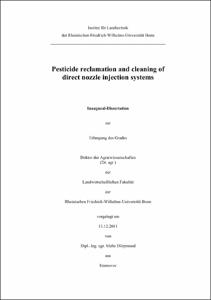Pesticide reclamation and cleaning of direct nozzle injection systems

Pesticide reclamation and cleaning of direct nozzle injection systems

| dc.contributor.advisor | Schulze Lammers, Peter | |
| dc.contributor.author | Dörpmund, Malte | |
| dc.date.accessioned | 2020-04-17T11:24:14Z | |
| dc.date.available | 2020-04-17T11:24:14Z | |
| dc.date.issued | 18.07.2012 | |
| dc.identifier.uri | https://hdl.handle.net/20.500.11811/5109 | |
| dc.description.abstract | Direct injection systems are considered a promising technology to apply pesticides site specifically in the future. Possible benefits of direct injection systems include improved cost efficiency, operator safety, and environmental protection compared with conventional sprayers. Over the past years research has focused mainly on the injection process including, response times, metering accuracy, and the mixing of the chemical and the carrier. However, with the proper cleaning of conventional sprayers becoming more and more important, it is crucial that studies on direct injection systems not only restrict themselves to dosing behaviour and accuracy, but also identify strategies to clean these systems. This includes the reclamation of the residual concentrated pesticide from the injection pipe and rinsing of the contaminated parts of the hydraulic system. In this study a direct injection system that injects pesticides locally at all nozzles on a boom was assembled and investigated under laboratory conditions with regards to its ability to be cleaned. The system was contaminated with a safe-to-use polyvinylpyrrolidone-water solution as a test pesticide before cleaning. The cleaning process was divided into two steps: 1) reclamation of the simulated pesticide by pushing it back into the pesticide tank using pressurised air (pre-cleaning) and 2) rinsing the contaminated part of the hydraulic system with water. Using gravimetrical and conductivity measurements, the cleaning process was investigated systematically to ascertain the initial dynamics of reclamation and rinsing, as well as the cleaning success. Evaluations included variation of pre-cleaning time and air pressure as well as water inlet positions. Measurements for a 3 m test section showed that the concentration of the simulated pesticide in the rinsing water could initially be as high as 30%. As the pre-cleaning time was extended, the initial concentration was reduced by one third. Changing the water inlet position reduced the initial concentration of the simulated pesticide in the rinsing water to 5%. These concentrations were much higher than in most common spray solutions. This means that if an active pesticide was used, further dilution of the pesticide concentration in the rinsing water would be required for it to be sprayed on a crop. In some cases it took more than 10 min to dilute simulated pesticide residues in a 3 m test section down to 0%. Measurements also showed that the contaminated rinsing water has to be homogenized in order to be able to uniformly control the dosing valves when applying the contaminated rinsing water to the crop. The test bench experiments were verified on a wide boom DIS sprayer. A method that included homogenization of the contaminated rinsing water was tested and proved to be suitable for future cleaning in the field after operation. | en |
| dc.language.iso | eng | |
| dc.rights | In Copyright | |
| dc.rights.uri | http://rightsstatements.org/vocab/InC/1.0/ | |
| dc.subject | Direkteinspeisungssysteme | |
| dc.subject | Präziser Pflanzenschutz | |
| dc.subject | Unkrautkontrolle | |
| dc.subject | Reinigung | |
| dc.subject | direct injection system | |
| dc.subject | precision agriculture | |
| dc.subject | cleaning | |
| dc.subject | weed control | |
| dc.subject.ddc | 630 Landwirtschaft, Veterinärmedizin | |
| dc.title | Pesticide reclamation and cleaning of direct nozzle injection systems | |
| dc.type | Dissertation oder Habilitation | |
| dc.publisher.name | Universitäts- und Landesbibliothek Bonn | |
| dc.publisher.location | Bonn | |
| dc.rights.accessRights | openAccess | |
| dc.identifier.urn | https://nbn-resolving.org/urn:nbn:de:hbz:5n-28953 | |
| ulbbn.pubtype | Erstveröffentlichung | |
| ulbbnediss.affiliation.name | Rheinische Friedrich-Wilhelms-Universität Bonn | |
| ulbbnediss.affiliation.location | Bonn | |
| ulbbnediss.thesis.level | Dissertation | |
| ulbbnediss.dissID | 2895 | |
| ulbbnediss.date.accepted | 21.05.2012 | |
| ulbbnediss.fakultaet | Landwirtschaftliche Fakultät | |
| dc.contributor.coReferee | Steiner, Ulrike |
Files in this item
This item appears in the following Collection(s)
-
E-Dissertationen (1118)




